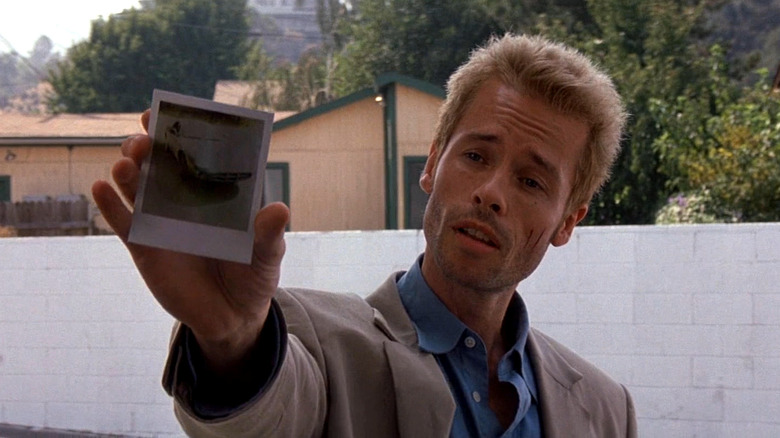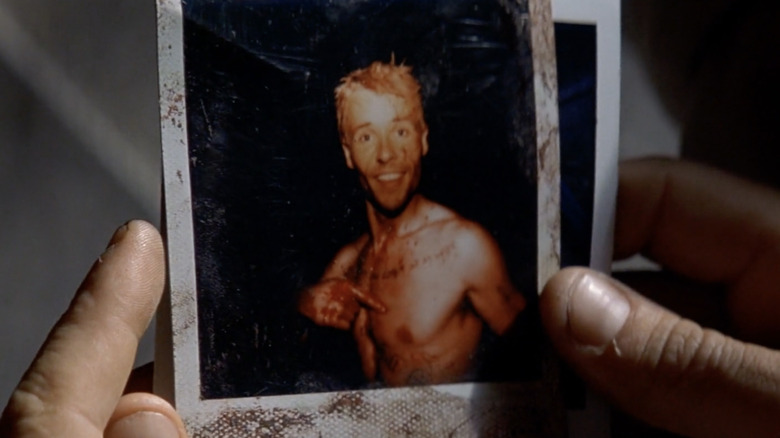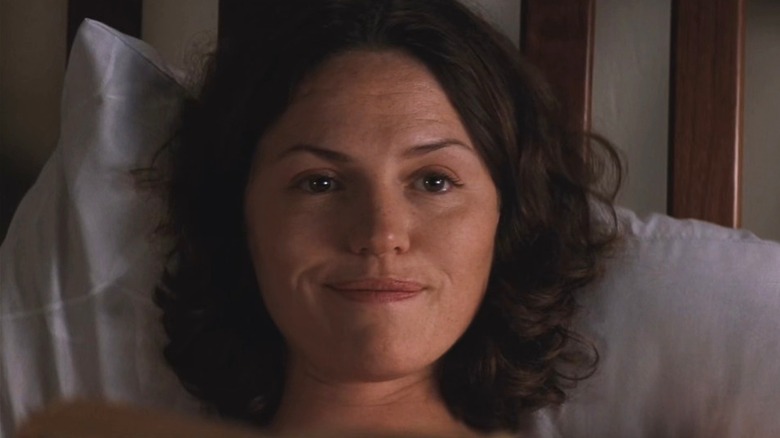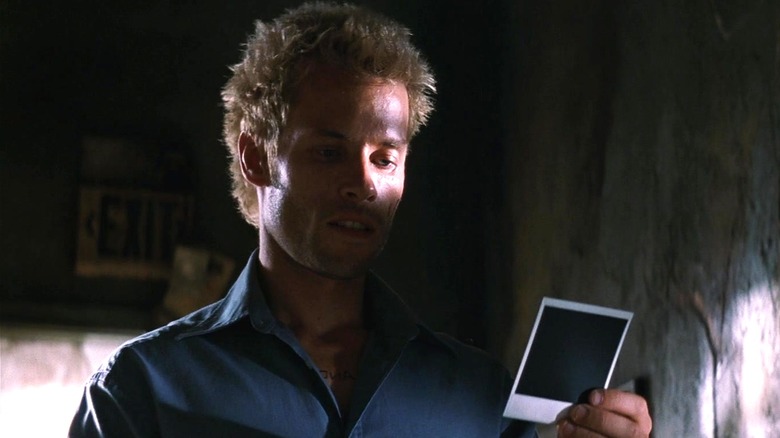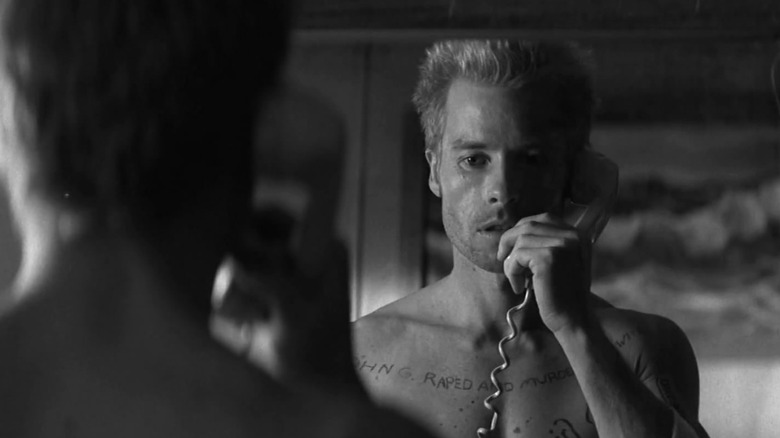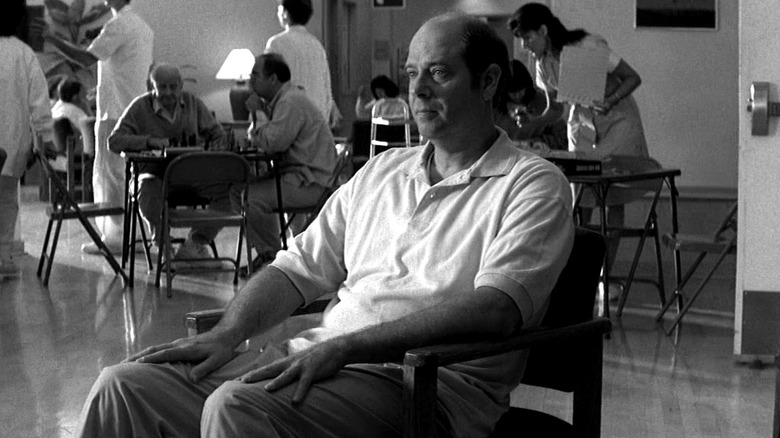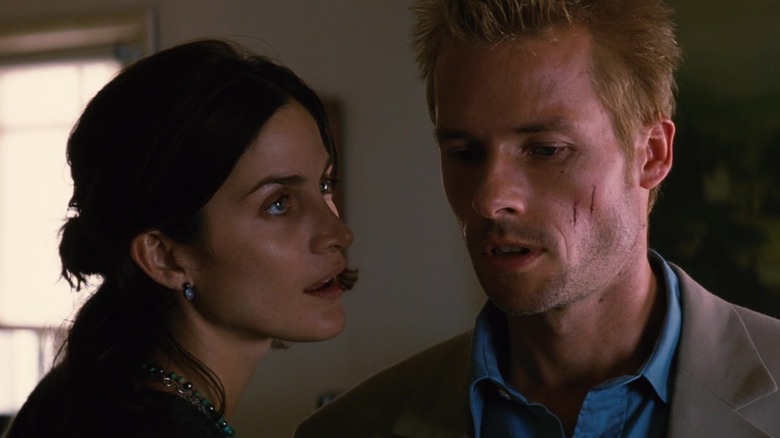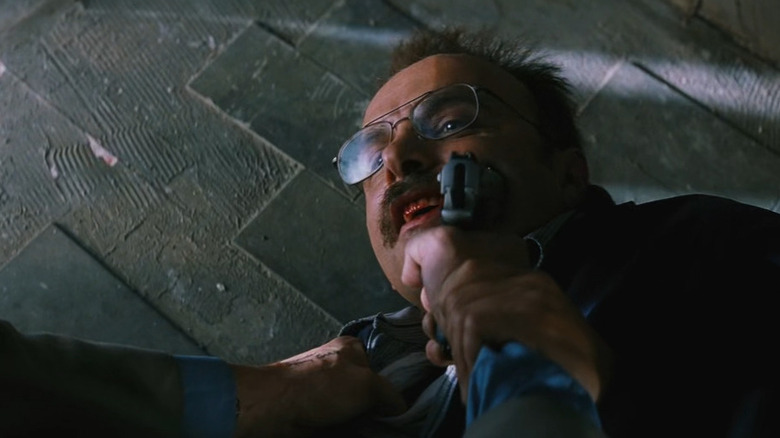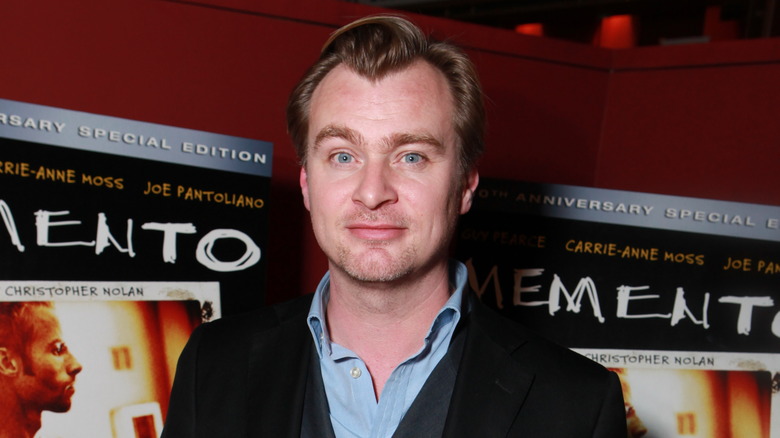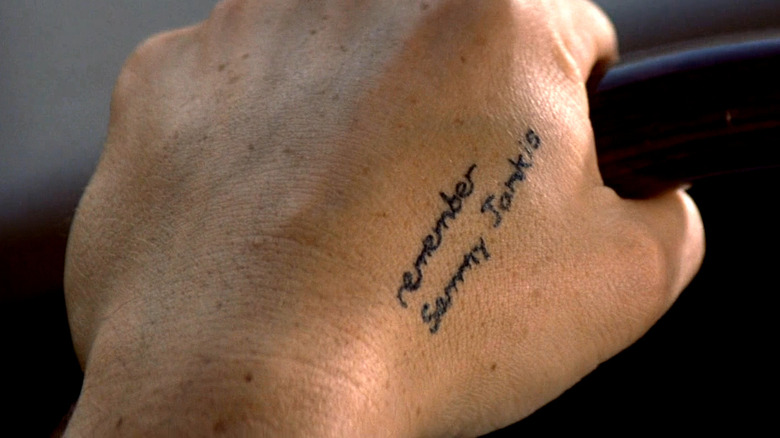The Ending Of Memento Explained - Who Are Teddy And Sammy Jankis, Really?
Before "The Dark Knight" or "Inception" changed the blockbuster, before "Oppenheimer" became one of the biggest movies of the 2020s, Christopher Nolan was just another director slowly making a name for himself with psychological thrillers. But just because he wasn't a superstar yet doesn't mean that he wasn't putting out stellar work. One of Nolan's first features, "Memento," remains a gem in his larger filmography — one that many casual moviegoers may have never heard of, but which diehard Nolan fans still revere.
As is often Nolan's way, "Memento" is an intentionally confusing film. A neo-noir with a psychological twist, the story follows former insurance claims investigator Leonard Shelby (Guy Pearce) who has developed anterograde amnesia after a traumatic experience and is unable to form new memories. In an attempt to piece together the truth, he uses a complex system of notes, photos, and tattoos to keep track of what he's uncovered. What ensues is a mind-bending film told in an appropriately mind-bending way.
It's a lot to take in on your first watch, but worry not. This is the ending of "Memento," one of Christopher Nolan's best films, explained.
What you need to remember about the plot of Memento
You can't discuss "Memento" without breaking down its unique format and how its narrative structure relates to the main character's mental state. To mirror Leonard's condition for the viewer, the film is told out of sequence.
"Memento" opens with Leonard shooting a man named Teddy (Joe Pantoliano) in the head, but for what reason, we have absolutely no idea. As the film goes on, we learn that Leonard's amnesia began the day his wife was sexually assaulted and killed in their home. Following a head injury sustained in the attack, Leonard must now meticulously remind himself of things with Polaroid photographs and notes that he has tattooed all over his body. After Teddy is shot, the movie begins showing us the events that lead to it one scene at a time — only in reverse. This means when a scene concludes, audiences are then shown the opening moments that had led up to it. These scenes run concurrently with a series of black-and-white sequences that detail Leonard telling a story about a man named Sammy Jankis (Stephen Tobolowsky), a man he knew who had the same amnesia, to someone on the phone.
As the narrative goes further back in time, we see how Leonard's condition can be taken advantage of, such as when a bartender named Natalie (Carrie Anne Moss) exploits it for her own needs. We also get to know Teddy, and with every interaction, we question along with Leonard whether or not he can be trusted.
What happened at the end of Memento?
As things unfold, we eventually understand that Leonard is on the hunt for one of the men who killed his wife. The film's final sequence begins in black and white, with him leaving his motel room to meet Officer John Gammell for the end of what's implied to be a long investigation. Together, the two have identified Jimmy Grantz (Larry Holden), a local drug dealer, as the "John G." who assaulted and murdered Leonard's wife. Gammell tells Leonard to write his name down as Teddy in his notes because he's undercover.
Sent by the crooked cop, Leonard arrives at an abandoned building outside of town to await Jimmy. The dealer shows up with $200,000 in cash, thinking he's there to do a major drug deal. Instead, Leonard strangles him to death. Just before Jimmy dies, though, he mutters the name "Sammy." Leonard suddenly realizes that Jimmy couldn't have been the right target, as he wouldn't have told him the story of Sammy Jankis. A moment later, Teddy arrives in his own car and Leonard demands to know the truth of what's going on.
Teddy explains that he was the cop assigned to Leonard's wife's case and that he actually helped Leonard track down her attacker "over a year ago." However, Leonard didn't remember, so Teddy started using him to take out other criminals who fit the "John G." clue, firing him like a guided missile to kill them and often conniving some money out of their deaths. He also reveals that Leonard's Sammy Jankis story has actually been Leonard's story the whole time.
Leonard is the one who killed his wife with insulin
Throughout "Memento," Leonard returns time and again to the story of Sammy Jankis. He explains that Sammy was someone he investigated in his former profession — a man who developed the same condition as Leonard and was unable to form new memories. Leonard deduced that Sammy was not eligible for the insurance claim he and his wife made, which led to tragic circumstances. Desperate to prove that her husband could still make new memories, Sammy's wife repeatedly asked him one day to give her her insulin injection — a necessary treatment for her diabetes. She asked him over and over again to give her the shot, convinced he'd eventually remember that he'd already done it, but he never did, leading to her overdose and death.
Teddy tells Leonard that this is actually his story. He says that the home invasion Leonard remembers did happen and that his wife was assaulted, but not killed. Leonard developed so much trauma over the incident, though, that his condition emerged. It was his wife who was diabetic and who died from an overdose trying to get him to remember.
This obviously shakes Leonard to his core, but it also reveals something else — that even with his condition, he has actually been able to internalize and alter some memories made after the attack through his use of mental conditioning. Teddy claims that Leonard's strategy of repetition has worked, as he's told the Sammy story so many times that he's come to believe it to avoid his own guilt.
What does the ending of Memento mean?
After hearing Teddy's explanation, Leonard sets himself on a specific course meant to alter the loop he's been living in. He refuses to kill Teddy in cold blood, but he leaves himself enough clues that he'll eventually convince himself the cop is the John G. he's been looking for. He also burns the photos of Jimmy's body and of Leonard smiling after killing the right man a year ago. As he drives away in Jimmy's car — a choice that quickly gets him entangled with Natalie, Jimmy's girlfriend — his inner monologue debates the morality of his decision and the truthfulness of his life.
"I have to believe in a world outside my own mind," he says. "We all need mirrors to remind ourselves who we are. I'm no different."
"Memento" is a story about the fallibility of memory — not just for Leonard, but for all of us. In the end, he accepts that he won't remember things the way they truly are. Every one of us at times adjusts our understanding of something that's happened to us. Leonard's victory is in reclaiming his agency despite his inability to remember. "I have to believe that my actions have meaning, even if I can't remember them," he says. Though Teddy has helped him in some ways, he's stolen the one thing Leonard seems to really value — a sense of self-direction. By setting himself on a collision course with Teddy, he accepts a future where he may never remember the truth. For him, though, that's better than a future where he never escapes the orbit of what happened to him.
Why does the film use black and white sequences?
From the early days of his career, Christopher Nolan was actively experimenting with how to play with the traditional three-act structure, something that we've seen consistently throughout his work. In the case of "Memento," Nolan chose to divide the film into two distinct sections: A color sequence and a black-and-white sequence.
The color sequences, told in reverse chronology, tell us the story of Leonard and his cyclical quest for vengeance on his wife's killer. These are interspersed with a series of non-color scenes, shot entirely in black and white, where Leonard is in his cheap hotel room. The main point of these colorless sequences is so Leonard can regale an unseen person on the phone with the story of Sammy Jankis.
What's also worth noting is how, unlike the color sequences, the black and white ones play out in proper chronological order. Not only is this a clever visual and tonal demarcation, but it allows us to see Leonard's character in two distinct lights. In the color sequences, we get to see Leonard pulled in all sorts of different directions by people, demonstrating fully how his memory issues impede his life. This is in stark contrast to the black-and-white sequences which show Leonard more in his element, recapping information that is concrete and accurate — at least as far as he knows at the time.
How does Memento's strange format elevate the twist ending?
"Memento" isn't like other movies, especially when it comes to how it's shot, edited, and presented. The movie defies many cinematic conventions and uses its own tricks to fully immerse the viewer, especially when it comes to the twist ending.
As we previously mentioned, the film is told through two distinct sections: a section filmed in color and another filmed in black and white. But now that we have a clear understanding of how these two sequences work individually, how exactly do they work in tandem with each other? This is truly where the magic of "Memento" kicks in, as Christopher Nolan, even early on in his career, had a good sense of how to build intrigue. As the color sections proceed in the opposite direction, we get all the film's needed context in reverse. So after key moments when a mind-boggling truth is revealed, we'll then cut back to the black-and-white scenes.
Not only does this fully immerse us into Leonard's perspective, but it also allows the film to bait and switch the audience several times. Things like Natalie's abusive betrayal of Leonard or the reveal of Leonard's self-maintained lie to himself really benefit from this gonzo format. While they are good reveals in their own right, their impact is increased significantly due to the nature of how they're revealed. We'll be told one thing in a scene then go back a bit in time, only to see the thing we were just told is a complete lie. The ending especially hits hard because, like Leonard, the viewer finally gets the explanation that they've wanted the whole film. However, due to how "Memento" is structured, you don't even know if you can trust it or not.
Why are so many people manipulating Leonard?
Despite many of his bizarre actions throughout the film, it's hard not to sympathize with Leonard and what he's going through. Not being able to remember something that may have only happened just a few minutes earlier is obviously tough. This also makes it very easy for people to take advantage of Leonard, which is revealed to be the case for both Natalie and, later on, Teddy.
With Natalie, due to the film's reverse chronology, we are initially led to believe that she is just an innocent bystander whom Leonard is simply helping out. However, as the film goes back in time, we learn that Natalie sees Leonard as a perfect pawn due to his condition. She even goes so far as to taunt Leonard over his dead wife so that he'll hit her, knowing she can then lie about where her injuries came from. This is all so she can trick Leonard into driving a man out of town for her.
In Teddy's case, he is significantly more sympathetic to Leonard's situation but, much like Natalie, has had zero issues using it to his benefit. Both serve as two more depressing examples of just how irreparably damaged Leonard's life has become due to his amnesia.
Is Leonard right to kill Teddy?
By the end of "Memento," most of the big questions have been answered. We understand how Leonard comes to kill Teddy in the first scene, why Natalie is so weird around him, and how the different pieces connect. But there are still some moral questions left hanging, such as whether or not Leonard is right to kill Teddy.
On the one hand, Teddy did help Leonard find the actual man he was looking for and exact his revenge. It's impossible to know if he's telling the whole truth when he says that he thought Leonard would remember, but what's certain is that when he didn't remember, Teddy used the situation for his own advantage. He's presumably grown rich off of their killing spree and covered up any evidence using his police privileges. It's also implied that they've only gone after criminals, though that leaves Teddy as the arbitrator of vigilante justice.
On the other hand, he's turned Leonard into a killer and robbed him of his agency — his life — for personal gain. He may truly believe that this is for the best, but it's a severe violation that Leonard just barely works his way out of. When Leonard kills him, he believes it's because Teddy murdered his wife, which is a lie. We also don't know what his life will look like now that Teddy is dead.
What Christopher Nolan has said about the ending of Memento
In a 2001 interview with Filmmaker Magazine, Christopher Nolan discussed "Memento" at length. Regarding the ending, he said that he hadn't expected how many people would doubt Teddy's confession in the final sequence.
"I think it's because people have spent the entire film looking at Leonard's photograph of Teddy, with the caption: 'Don't believe his lies,'" Nolan said. "That image really stays in people's heads, and they still prefer to trust that image even after we make it very clear that Leonard's visual recollection is completely questionable." This seems to be a confirmation that most of what Teddy says is true, though that remains somewhat ambiguous.
Speaking with Creative Screenwriting in 2015, Nolan again discussed the ending and larger truth of "Memento," explaining that a core piece of it for him was always "the concept of revenge; what the inability to remember does to the whole idea of revenge." This angle leaves Leonard's story a bit less resolved than it seems to be at the end of the movie. "To me," Nolan said, "it raises all kinds of very interesting ideas about whether revenge exists in any real sense outside of your own head, or whether it's your own personal satisfaction and whether it has any value outside of that."
What the ending of Memento could mean for the franchise
"Memento" doesn't have a direct sequel, but that doesn't mean it hasn't impacted the rest of Christopher Nolan's filmography. From a stylistic perspective, Nolan has continued implementing unique narrative structures within his films, such as "Dunkirk" and "Oppenheimer." Even the ending of "Memento" has influenced Nolan's subsequent films, especially by being the first example of him ending a film on an ambiguous note. Another example of this is "Inception," where the end credits pop up before you find out if the top has stopped spinning.
Additionally, the film and its ending have done more than influence Nolan's other films: It also affected the mental state of its lead. Per an interview with GQ, Guy Pearce revealed that "[The script] felt like gobbledegook as I was reading it, because you got the sense that things were all over the place, what I really got and what was really clear was the emotional journey of the character." Pearce then went on to explain that his immersion into his role led to him worrying about his own grasp of reality.
He went on to say, "I [would] look at a photo and base a memory around that and go, 'I actually don't really know if that memory is really true. Is it?' So it really made me question my own memory. Thanks, Chris Nolan."

